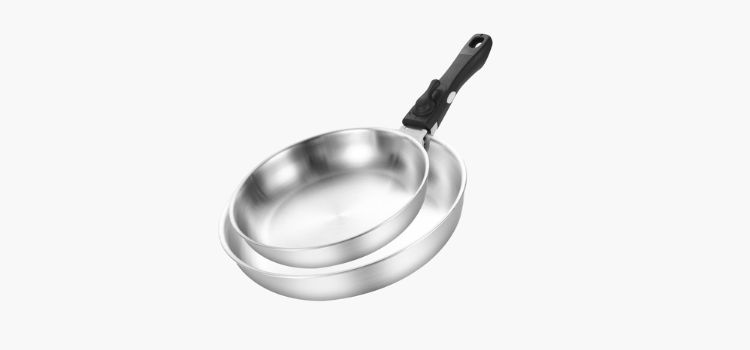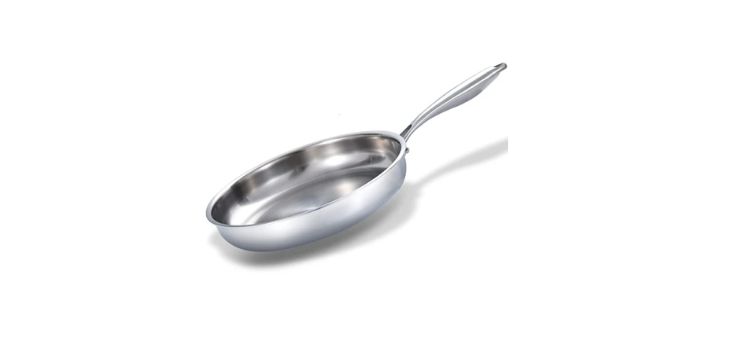As an Amazon Associate, I earn from qualifying purchases

Tri-ply stainless steel cookware has been gaining popularity in kitchens around the world, embraced by both professional chefs and home cooks. Known for its durability and superior heat distribution, this type of cookware promises to deliver consistent cooking results. Its sleek, modern design also makes it an attractive addition to any kitchen.
However, as people become more conscious about health and safety in their cooking practices, questions arise about the safety of using tri-ply stainless steel cookware. This article delves into what makes tri-ply stainless steel cookware a favorite and examines whether it poses any safety concerns.
Composition and Benefits of Tri-Ply Stainless Steel Cookware
To understand why tri-ply stainless steel cookware is so highly regarded, it’s crucial to look at its composition. “Tri-ply” refers to the three layers of material used in its construction. Typically, this involves a core layer of aluminum or copper sandwiched between two layers of stainless steel. Each material serves a specific purpose: stainless steel provides a non-reactive and durable cooking surface, while aluminum or copper ensures excellent heat conduction.
The benefits of this construction are immediately apparent. The aluminum or copper core allows for even heat distribution across the cooking surface, reducing the likelihood of hot spots that can scorch food. This uniform heat distribution means your dishes cook more evenly, resulting in better texture and flavor. Additionally, stainless steel’s non-reactive nature ensures that it doesn’t leach into your food, preserving the taste and nutritional integrity of your ingredients.
When compared to other types of cookware, such as non-stick or cast iron, tri-ply stainless steel offers a balance of performance and versatility. Unlike non-stick pans, tri-ply stainless steel can handle high heat, making it suitable for searing and browning. It’s also more forgiving when it comes to cleaning, as it can withstand more rigorous scrubbing than non-stick surfaces.
Potential Safety Concerns
- Metal Leaching: Consumers worry about metals leaching into food, especially when cooking acidic items like tomatoes or citrus. While tri-ply stainless steel cookware features a stainless steel layer that acts as a protective barrier, ensuring minimal interaction with food, it’s important to be cautious and choose high-quality products to mitigate this risk.
- Non-Stick Coatings: Some tri-ply cookware comes with non-stick surfaces, which can raise concerns. Older non-stick coatings have faced criticism for potentially releasing harmful substances at high temperatures. Although modern non-stick options are generally deemed safer, it’s essential to check the specific materials used to ensure safety.
- Manufacturing Quality: The safety of tri-ply stainless steel cookware significantly depends on the manufacturer’s quality standards. Reputable brands often adhere to strict manufacturing guidelines, ensuring their products are safe for everyday use. In contrast, cheaper alternatives may not meet these standards, increasing the risk of safety issues for consumers.
Scientific Studies and Expert Opinions

Research into the safety of tri-ply stainless steel cookware has largely supported its use. Studies show that the stainless steel surface effectively prevents metal leaching, even when cooking acidic foods. The aluminum or copper core, essential for heat conduction, remains safely encapsulated between the layers of stainless steel.
Experts in both health and culinary fields generally agree on the safety and effectiveness of tri-ply stainless steel cookware. Many chefs prefer it for its performance and durability, while health professionals highlight its non-reactive cooking surface as a benefit for those concerned about food contamination.
The consensus in the culinary world seems to be that, when used properly, tri-ply stainless steel cookware is a reliable and safe choice. This is particularly true when it comes from reputable manufacturers who prioritize safety and quality.
Tips for Safe Usage of Tri-Ply Stainless Steel Cookware
For those looking to maximize safety and longevity while using tri-ply stainless steel cookware, a few best practices can be helpful:
- Maintain Your Cookware: Regular maintenance, including thorough cleaning and drying, can help preserve the integrity of your cookware. Avoid using harsh chemicals or steel wool that can scratch the stainless steel surface.
- Avoid Extreme Temperatures: Sudden changes in temperature can warp even high-quality cookware. Allow pans to cool before washing and avoid preheating empty pans on high heat.
- Monitor for Damage: Regularly inspect your cookware for signs of damage such as warping or pitting, which can affect performance and safety.
- Choose the Right Utensils: Use wooden, silicone, or nylon utensils to prevent scratching the cooking surface.
- Mind the Coatings: If your cookware has a non-stick layer, avoid using metal utensils and high heat to prolong its life and ensure safety.
Conclusion
In summary, tri-ply stainless steel cookware is generally considered safe, offering numerous benefits that make it a preferred choice for many cooks. Its composition of stainless steel and an aluminum or copper core provides excellent cooking performance while maintaining a non-reactive surface that is unlikely to leach any harmful substances into your food. By following simple maintenance and usage guidelines, users can enjoy the benefits of tri-ply cookware with peace of mind.
As with any product, it’s essential to research brands and choose cookware that meets high safety standards. Ultimately, tri-ply stainless steel cookware balances safety, performance, and aesthetic appeal, making it a valuable addition to any kitchen. Making informed choices based on personal cooking needs and safety considerations will ensure that this favored cookware remains a staple in your culinary endeavors.
FAQ
Is tri-ply stainless steel healthy?
Tri-ply stainless steel is generally considered healthy for cooking. It features a non-reactive stainless steel surface that prevents chemical leaching into food. Its aluminum or copper core ensures even heating without direct food contact. Ensure the cookware meets safety standards, and avoid overheating to maintain health benefits.
What are the side effects of tri-ply cookware?
Tri-ply cookware is typically safe, but potential side effects can include minor metal leaching if the stainless steel surface is damaged. Avoid using high heat and cooking acidic foods in damaged cookware. Proper maintenance, such as avoiding scratches and warping, minimizes risks and ensures safety.
Which one is better, tri-ply or stainless steel?
Tri-ply cookware generally outperforms standard stainless steel due to its superior heat distribution, thanks to the aluminum or copper core. This feature enhances cooking efficiency and reduces hot spots. However, standard stainless steel is often lighter and more affordable, making it suitable for basic kitchen tasks.
As an Amazon Associate, I earn from qualifying purchases